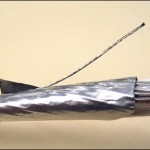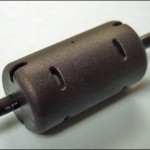Effective Shielding of Cables Part 3

A foil shield requires a drain wire to facilitate terminating the shield
Foil Shields
A foil shield consists of metallic foil, typically aluminum, laminated to a polyester or polypropylene film. Foil shields provide 100% coverage with the foil typically wrapped in overlapping layers around the cable core. The 100% coverage is a physical property and does not mean that a foil shield provides 100% EMI shielding. Foil shields are effective at shielding both high and low frequency interference. Foil shields are lighter weight, less bulky, and typically add less cost to a cable or wire assembly than braided or spiral shields.
Foil shields may be more flexible than a braided shield but typically have a shorter flex life. A drain wire, which runs the length of the cable in contact with the foil shield, makes a reliable electrical termination of a foil shield possible.

Example of a complex multi-core cable with a foil shield on inner conductors and an outer braided shield
Combination Shields
Combination shields consist of more than one layer or type of shielding and provide maximum efficiency across a wider frequency spectrum. The combination braid-over-foil combines the strength and flexibility of a braided shield with the advantages of 100% coverage of a foil shield.
Comparison of Common Shielding Methods
The following chart offers a comparison of the three types of shielding discussed and a summary of electrical and mechanical performance for each:

Cable Shielding Characteristics

Ferrite bead fixed over cable
Ferrite Beads
While ferrite beads are not a shield, they can have the effect of shielding. Where high-frequency noise may be a problem, ferrite attenuators are often used. These are placed around a cable to absorb extraneous and unwanted energy traveling on the cable. Low frequency and DC signals see only the conductor and are unimpeded, but higher frequency signals are suppressed and dissipated, reducing EMI interference.
Summary
EMI and RF interference can degrade signals making diagnosis difficult or even impossible. Effective shielding can reduce unwanted interference and reduce the amount of active filtering needed within the device.
The Affinity and Molex engineering teams have experience and expertise to assist you in designing medical cable assemblies with appropriate and adequate shielding for your specific application.